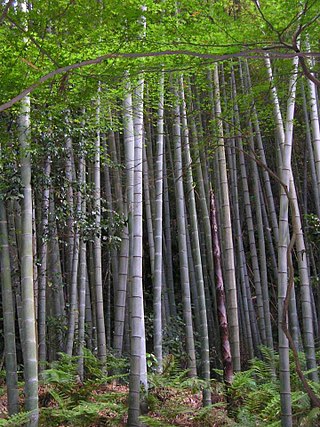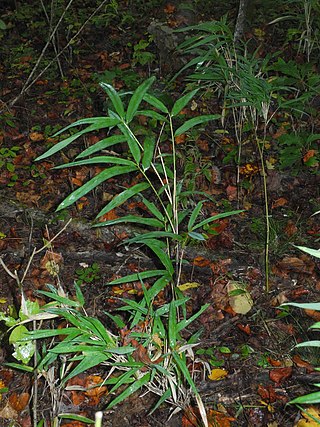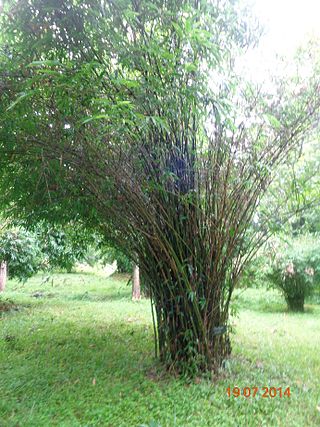
Bamboos are a diverse group of mostly evergreen perennial flowering plants making up the subfamily Bambusoideae of the grass family Poaceae. Giant bamboos are the largest members of the grass family, in the case of Dendrocalamus sinicus individual culms reaching a length of 46 meters, up to 36 centimeters in thickness and a weight of up to 450 kilograms. The internodes of bamboos can also be of great length. Kinabaluchloa wrayi has internodes up to 2.5 meters in length. and Arthrostylidium schomburgkii with lower internodes up to 5 meters in length, exceeded in length only by papyrus. By contrast, the culms of the tiny bamboo Raddiella vanessiae of the savannas of French Guiana are only 10–20 millimeters in length by about two millimeters in width. The origin of the word "bamboo" is uncertain, but it probably comes from the Dutch or Portuguese language, which originally borrowed it from Malay or Kannada.

Thyrsostachys is a genus of Chinese and Indochinese bamboo in the grass family.
- Thyrsostachys oliveri Gamble - edible-seeded bamboo - Yunnan, Myanmar, Laos, Thailand; naturalised in Assam + Bangladesh
- Thyrsostachys siamensis Gamble - monastery bamboo, Thai bamboo, umbrella bamboo, Thai umbrella bamboo, umbrella-handle bamboo - Yunnan, Myanmar, Laos, Thailand, Vietnam; naturalised in Sri Lanka, Bangladesh, Peninsular Malaysia

Bambusa vulgaris, common bamboo, is an open-clump type bamboo species. It is native to Indochina and to the province of Yunnan in southern China, but it has been widely cultivated in many other places and has become naturalized in several regions. Among bamboo species, it is one of the largest and most easily recognized.

Arundinaria appalachiana, commonly known as hill cane, is a woody bamboo native to the Appalachian Mountains in the southeastern United States. The plant was elevated to the species level in 2006 based on new morphological and genetic information and was previously treated as a variety of Arundinaria tecta. The shortest member of its genus, hill cane ranges from 0.4–1.8 meter tall with a habit ranging from diffuse to pluri-caespitose. It is one of only three temperate species of bamboo native to North America. Hill cane is common on dry to mesic sites on upland slopes, bluffs and ridges in oak-hickory forests, which distinguishes it from other species in the genus: Arundinaria gigantea typically appears along perennial streams, while Arundinaria tecta is found in swamps and other very wet areas.

Bambusa tulda, or Indian timber bamboo, is considered to be one of the most useful of bamboo species. It is native to the Indian subcontinent, Indochina, Tibet, and Yunnan, and naturalized in Iraq, Puerto Rico, and parts of South America.

Phyllostachys rubromarginata, the reddish bamboo or red margin bamboo, is a species of Phyllostachys bamboo, native to Central China, specifically Guangxi and Guizhou.

Bambusa lako, known as Timor black bamboo, is a large species of bamboo originating from the island of Timor; its black culms may reach 21 m (69 ft) in height. A 2000 molecular study places it as closely related to the similar Indonesian species Gigantochloa atroviolacea, from which it was separated in 1997; it may soon be placed in that genus. Bambusa lako can only be grown in climates that are mostly frost-free.

Dendrocalamus strictus is a bamboo species belonging to the Dendrocalamus genus. The culms (stems) are often solid. Common names include male bamboo, solid bamboo, and Calcutta bamboo.

Bambusa bambos, the giant thorny bamboo, Indian thorny bamboo, spiny bamboo, or thorny bamboo is a species of clumping bamboo native to southern Asia. It is also naturalized in Seychelles, Central America, West Indies, Java, Malaysia, Maluku, and the Philippines.

Phyllostachys bambusoides, commonly called madake, giant timber bamboo, or Japanese timber bamboo, is a species of flowering plant in the bamboo subfamily of the grass family Poaceae, native to China, and possibly also to Japan.

Engleromyces sinensis is a species of fungus in the family Xylariaceae. It was described as new to science in 2010, based on specimens collected in 1958 and incorrectly identified as Engleromyces goetzii. The fungus is known only from China, where it grows on bamboo culms. It forms fruit bodies in the shape of two roughly circular buff-colored lobes measuring up to 50 cm (20 in) in diameter that envelop the bamboo. E. sinensis has been used as a folk remedy against cancer and infection in Tibet, Yunnan, and Sichuan Provinces. Several bioactive metabolites have been isolated and identified from the fungus.

Dendrocalamus asper, also known as giant bamboo or dragon bamboo, is a giant, tropical, clumping species of bamboo native to Southeast Asia. In addition to its prolific nature across Asia, the plant's overall attractive appearance has seen this species introduced widely across South America and Africa, as well as Mexico and Florida. One advantage of this bamboo, especially for gardens, is its natural growth habit as a sympodial, colony-forming plant. Overall this bamboo maintains its own "personal" growing space, and does not grow laterally (runners), thus posing less risk of being environmentally-invasive.

Dendrocalamus hamiltonii, or Hamilton's bamboo, is a species of bamboo, 12–15 cm in diameter and growing up to 15–18 m in height, found in South Asian countries such as, India, Sri Lanka, Bhutan, Nepal, Pakistan, and far eastern China.
Dendrocalamus giganteus, commonly known as giant bamboo, is a giant tropical and subtropical, dense-clumping species native to Southeast Asia. It is one of the largest bamboo species in the world.

Ochlandra stridula, the Ceylon reed-bamboo, reed bamboo or forest bamboo, is a species of bamboo in the grass family). It is endemic to Sri Lanka. It can be found extensively in Ratnapura and Kegalle districts, in waste lands of rainforest and also along stream banks and in forest gaps.
Neololeba atra, the black bamboo, is a species of tropical Asian, Australian, and Papuasian bamboos in the grass family Poaceae.

Bambusa polymorpha, or Burmese bamboo, is a species of clumping bamboo native to Bangladesh, Laos, Myanmar, Thailand, Sri Lanka, Java, Cuba, Puerto Rico, and Ecuador.
Dendrocalamus longispathus, the long-sheath bamboo, is a bamboo species which grows up to 20 m tall. It is native to Bangladesh, Myanmar, and Thailand. It has now become an exotic species all over the South Asia.

Gigantochloa atter, the black bamboo, sweet bamboo, or giant atter, is a bamboo species belonging to the genus Gigantochloa. It grows up to 20 m tall. It is native to Island Southeast Asia, but has become naturalized all over the South Asia.
Melocanna baccifera is one of two bamboo species belonging to the Melocanna genus. It grows up to 10–25 m tall. It is native to Bangladesh, Myanmar, India, and Thailand.
















